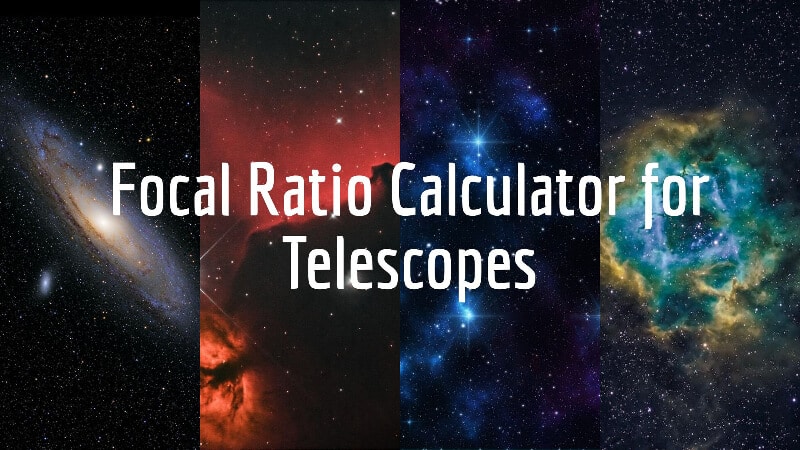The focal ratio formula for a telescope is:
Focal Length (mm) / Aperture (mm) = Focal Ratio (F-Number)
See below our calculator to work this out for you:
Focal Ratio Calculator
How to use the Focal Ratio Calculator
You need to enter two pieces of information to calculate your telescope’s focal ratio:
- The aperture of your telescope in millimeters
- The focal length of your telescopes in millimeters
You then press Calculate and you will get the focal ratio as an f-number.
If you don’t know the aperture or focal length of your telescope you can do a quick Google of the make and model and find the specifications online.
Read on to understand more about focal ratio and what the f-number means.
What is Focal Ratio for a Telescope?
Focal ratio is a quantitative measure of a telescope’s “speed”. I.e. how quickly it gathers light:
- A faster focal ratio means it gathers light more quickly and efficiently. This therefore means it is more capable of imaging faint objects and reduces exposure time.
- A slower focal ratio means it gathers light less efficiently. This therefore means it may struggle to photo faint astronomical objects and require longer exposure time.
Focal ratio is indicated by an f/number and the smaller the number the faster the telescope. For example:
- F/2 is a fast focal ratio
- F/12 is a slow focal ratio
Focal ratio is also referred to as the “f-ratio”.
This video provides a good further explanation:
Focal Ratio Formula FAQs
What is the meaning of focal ratio?
Focal ratio is a way of determining how “fast” a telescope or camera lens is at gathering light.
How do you calculate focal ratio?
Focal ratio is calculated by dividing focal length by aperture. This gives you an f-number that is the focal ratio.
What is the best focal ratio? Is higher focal ratio better?
In general, the faster the focal ratio the better, especially for astrophotography.
But you also have to consider the other key specifications like aperture and focal length:
- The higher aperture the better for gathering light. The downside being the higher this is the more expensive the telescope.
- The longer the focal length the narrower the field of view. So long focal lengths can be good for planetary imaging but not good for widefield deep sky objects
What is a fast focal ratio?
A fast focal ratio is generally considered to be in the range of F/2 to F/5.
What are some focal ratio examples?
Some focal ratio examples are:
- Celestron RASA 11″: 620mm focal length / 279mm aperture = f/2.2 focal ratio
- Unistellar eVscope 2: 450mm focal length / 114mm aperture = f/3.9 focal ratio
- Sky-Watcher Esprit: 400mm focal length / 80mm aperture = f/5 focal ratio
- Takahashi TOA 130NFB: 1000mm focal length / 130mm aperture = f/7.7 focal ratio
- Meade 8″ ACF LX90: 2000mm focal length / 203mm aperture = f/10 focal ratio
What is the focal ratio of a lens? How do you find the F-ratio of a lens?
With camera lenses, the focal ratio is usually in the model name.
For example, the Canon EF 50mm f/1.8 lens: f/1.8 is the focal ratio. Although with camera lenses this is sometimes referred to as the aperture – see Is Higher Aperture Better? for more on this.
What is the best focal ratio for visual astronomy?
Focal ratio is less important for visual astronomy than it is for astrophotography.
The key specifications for astronomy are aperture and focal length which will tell you what you need to know about the telescope in terms of its light-gathering capacity and field of view.
For more on this, see our article on the Best Focal Ratio for Astrophotography.
What’s the best focal ratio for viewing planets?
A slow focal ratio like f/10 or above can be adequate for viewing planets. This is because they are relatively bright objects in the night sky.
A key thing to look for though is a long focal length, as this gives you high magnification and a narrow field of view.
What is a focal reducer?
A focal reducer is an accessory that can be used with a telescope to make the focal ratio faster.
Related articles:



